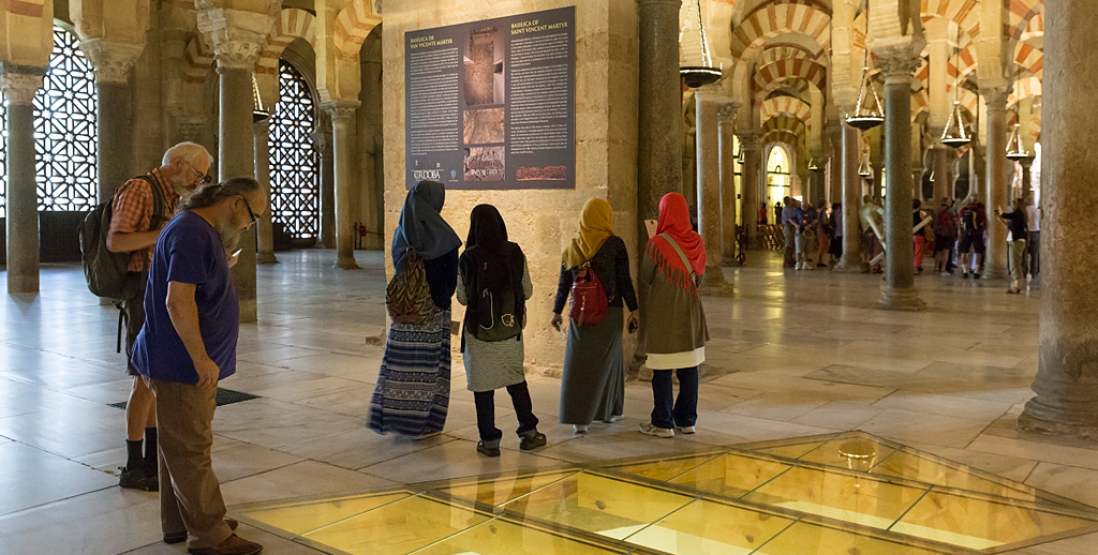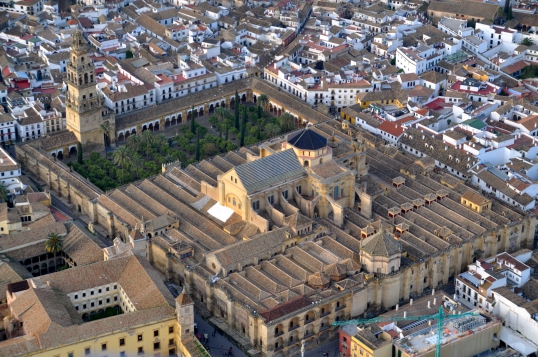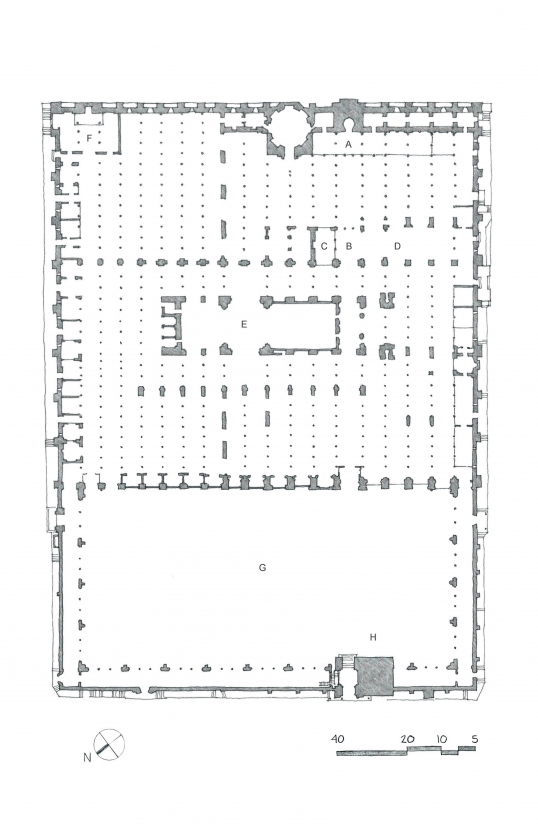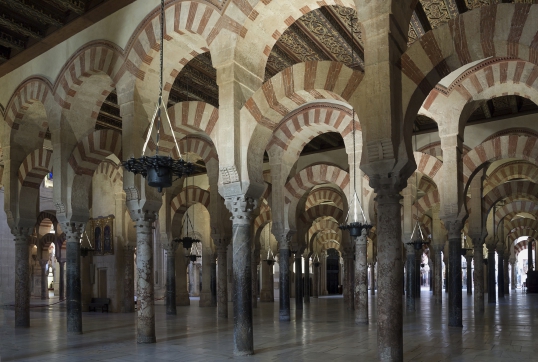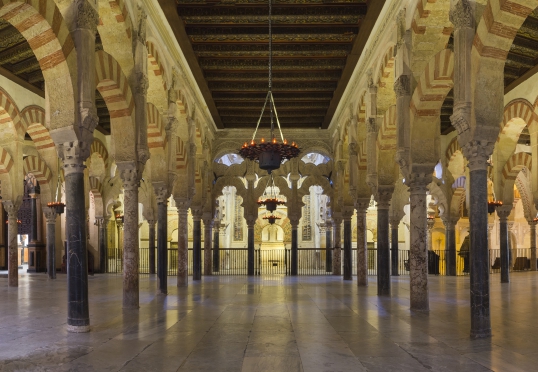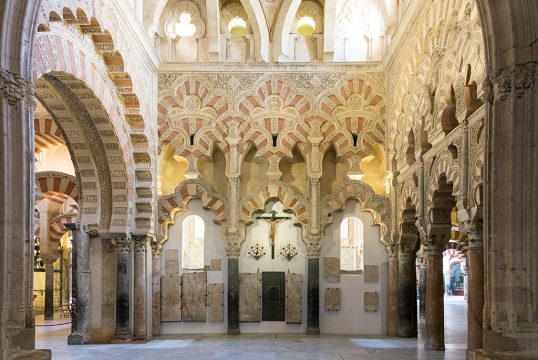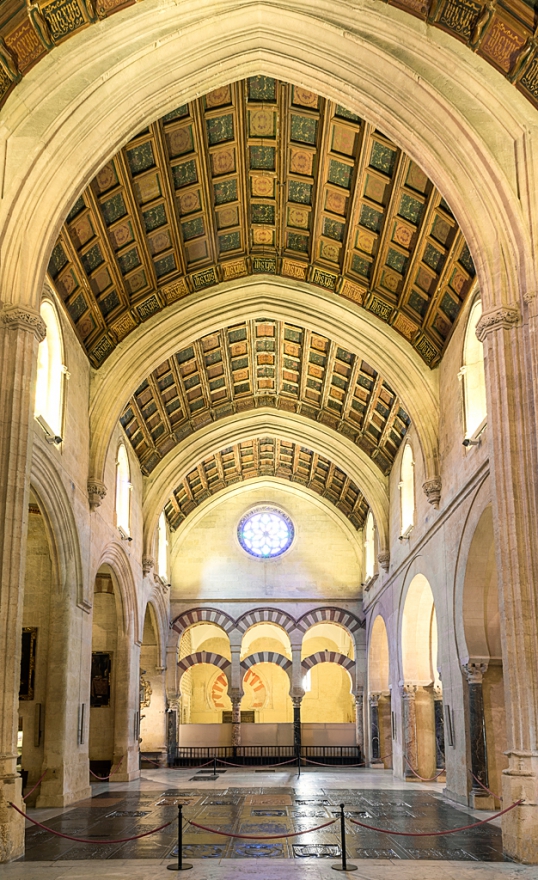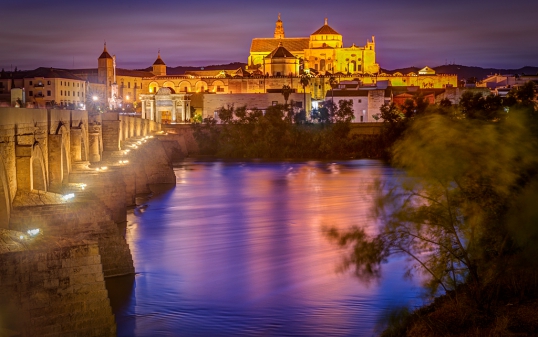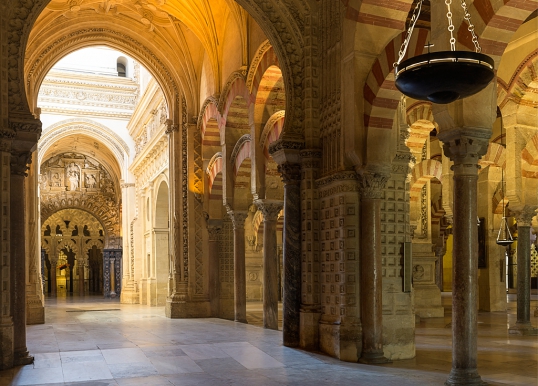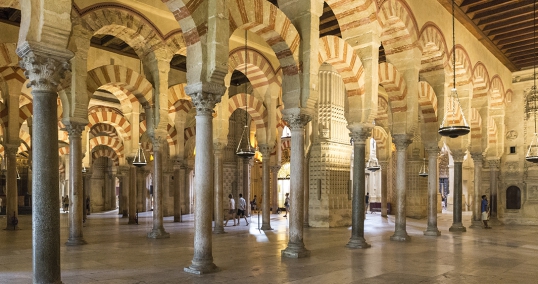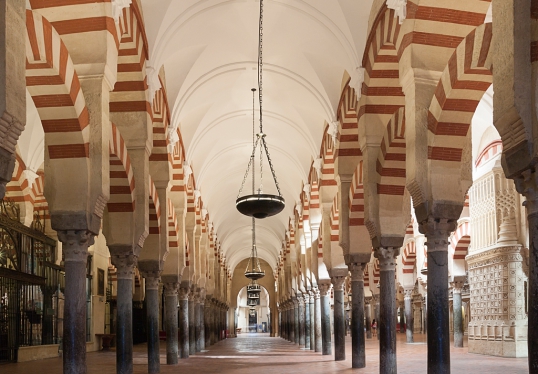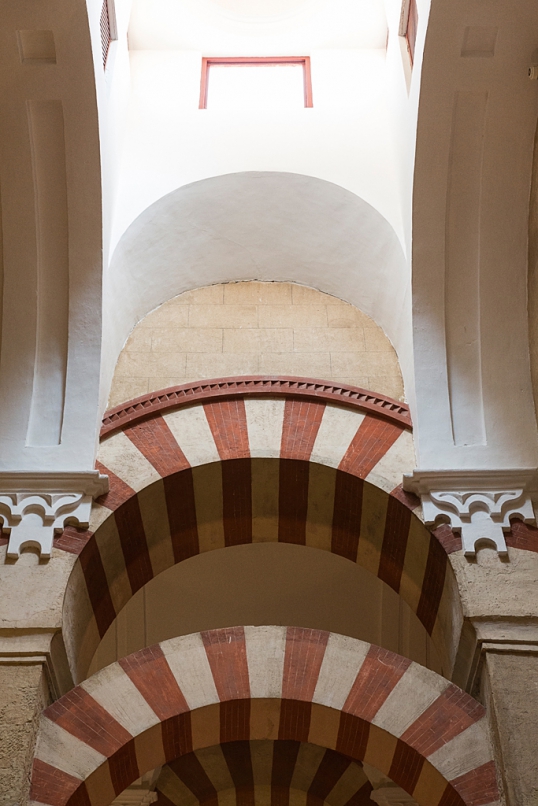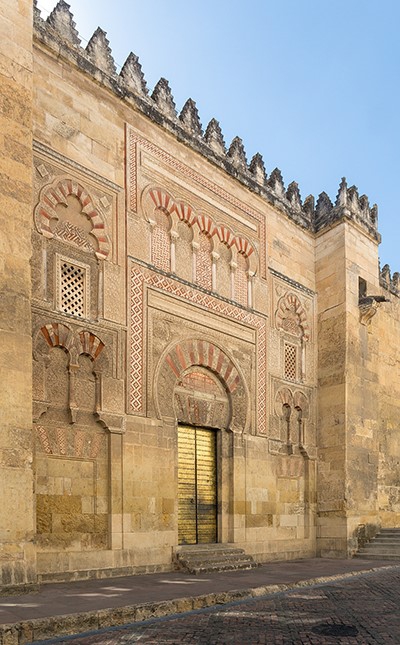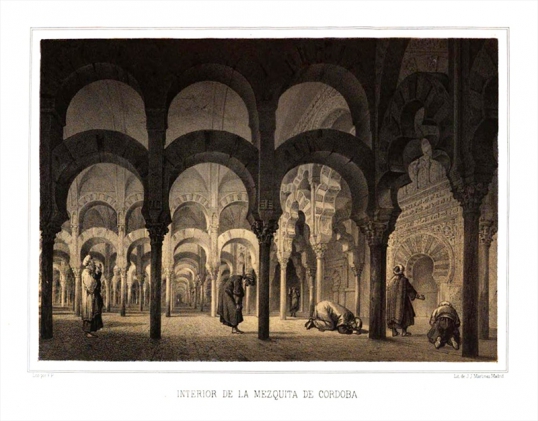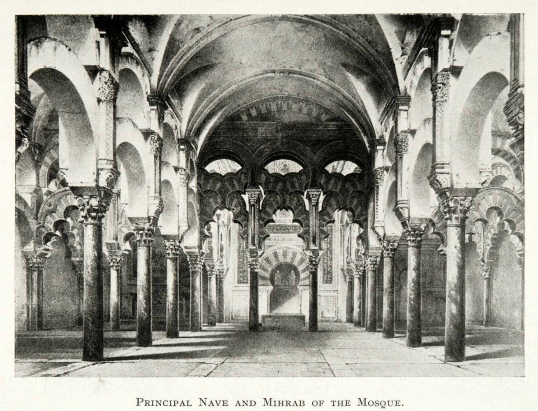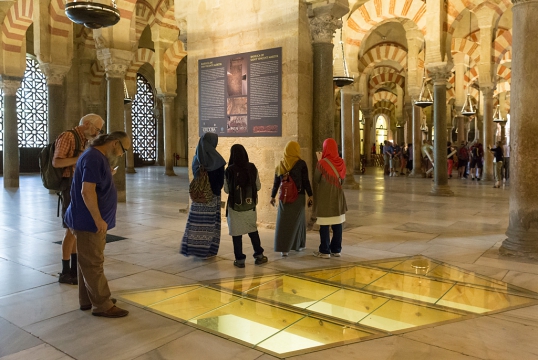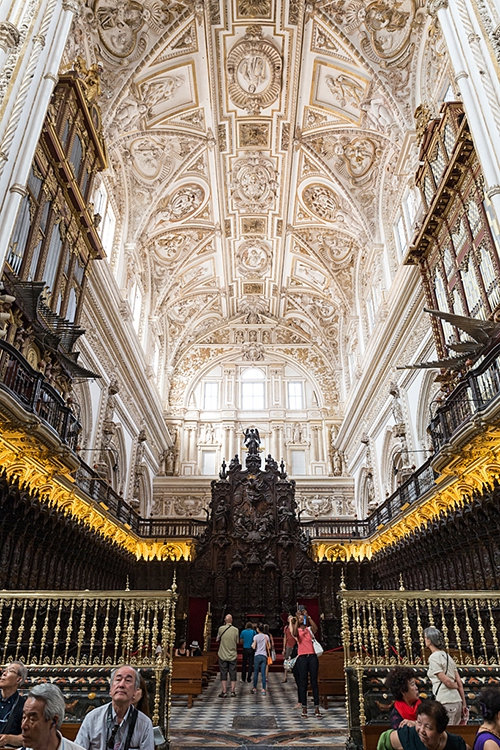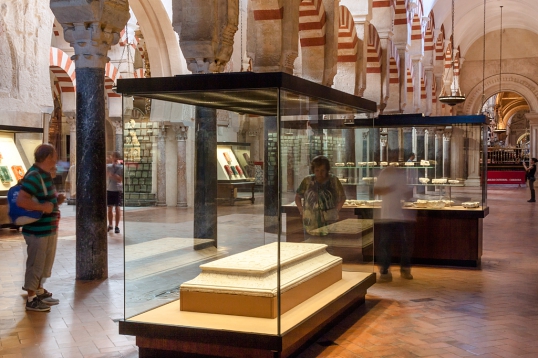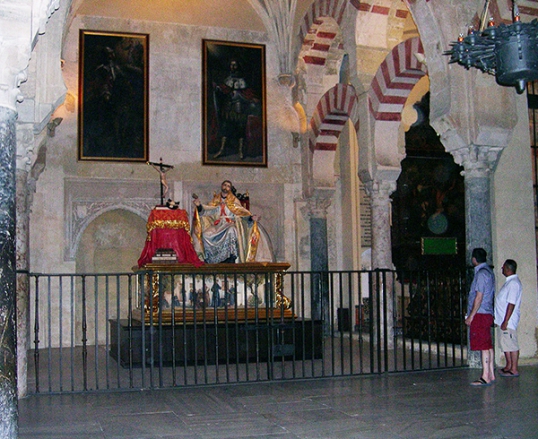Memento Mauri: The Mosque-Cathedral of Cordoba
Fig. 15. In situ remains of a building were revealed to the public in 2005; the interpretive panel suggests that it is the Basilica of San Vicente, which was allegedly demolished to make way for the mosque. But some scholars disagree.
Cordoba is a city of ghosts. Of course, it could be said that Spain is a country of ghosts, but the effect is heightened in the south, the site of so much of the nation’s pathos. Since the late nineteenth century, these ghosts have haunted modern attempts to save the city’s heritage and to attract tourism. An historic zone was identified for protection as early as 1912; the aim, in the words of the mayor, was
to perpetuate and sustain, to the extent possible, the typical character of our population in the districts which, through the classic structure of their streets and the aspect of the overall ensemble, evoke the memory of extinguished races and the events of distant eras, and excite the curiosity of those who visit it.1
When the heritage project started, these “extinguished races,” Muslims and Jews, had been absent from the peninsula for hundreds of years. They were forcibly converted and ultimately expelled in the early modern period—part of the process of creating a unified and fully Catholic state.2 These absent presences haunt the city and surrounding landscape: unusual church layouts, indebted to the plans of the mosques on which they are built; minarets hidden within bell towers; buildings rumored to be synagogues; street names that evoke the city’s Arab-Islamic past, and others that recall the atrocities of the Inquisition. But some of the ghosts are more recent: empty monasteries seized by the Liberal state in the nineteenth century; beheaded statues in churches attacked by anti-clerical rioters during the Civil War; the unmarked graves of victims of Franco’s reign of terror. The so-called “pact of forgetting,” which accompanied Spain’s transition to democracy, in a sense characterizes the whole of Andalusian history.3 History—or rather particular histories—have been repeatedly buried, only to be partially excavated, then buried again in a new cycle of forgetting.
A remarkable building stands in the heart of Cordoba, as if in defiance: the so-called Mezquita-Catedral, the “Mosque-Cathedral” (Fig. 1). One of the great monuments of world architecture, it is the city’s claim to fame: the source of its pride, wealth, and anxiety. Although the building has been a cathedral for almost eight centuries, most locals still refer to it as “la Mezquita (the mosque).” In recent years, the Church has tried to change that. A dispute has been raging between the Church and citizen activists over the control and meaning of the building. The intensity of the dispute is surprising to outsiders, especially given the pressing problems of the region: in particular, a desperate economic situation that has left a generation without work and an insecure future, fueling yet another wave of Andalusian migration to other parts of Spain and beyond. Only gradually does one become aware that the conflict over the Mezquita is as much about the present as it is about the past. Indeed, the two are inextricably intertwined. The back-story of the conflict is made up of interlocking threads—all of which can be traced, directly or indirectly, to layers in the building itself.
Fig. 1. Aerial view of the Mosque-Cathedral of Cordoba, 2010.
Photograph courtesy of tonicastillo.com.
The Mezquita is the most magnificent of the Friday or congregational mosques that were the center of religious and civic life under Islamic rule, which lasted in various forms on the peninsula for some seven centuries (eight–fifteenth centuries). When Castilian forces conquered cities (eleventh–fifteenth centuries), they consecrated mosques for Christian worship. Eventually they demolished them and built cathedrals—a process that mirrors the appropriation of sacred Christian sites by Muslims in Spain and elsewhere.4 But Cordoba’s Mezquita survived. Over the centuries, it was modified for Catholic worship, culminating in the insertion of a massive choir and presbytery in the sixteenth century (the structure is usually called a coro-crucero, or simply crucero, “transept”). Christian interventions responded to the structural, spatial, and symbolic qualities of the mosque. As at other cathedrals, these interventions were motivated by new liturgical needs and changing tastes.5 But this is not just any cathedral. It is a cathedral housed in the former Great Mosque of Cordoba—a building that symbolizes Islam at the height of its power in Europe. Throughout the centuries, the Mezquita has been a place of worship, a beloved monument, and also a potent reminder of the Islamic past. We can read cycles of patronage, demolition, and restoration as an index of changing attitudes toward that past and the specter of the Moor: a recurrent image of self and other in Spanish history.6
A Building “Unique in the World”
The Great Mosque was constructed in several phases under the Umayyad dynasty which, exiled from Syria, established a powerful empire on the Iberian peninsula (eight–eleventh centuries). The original mosque of Abd al-Rahman I (784–785) was twice extended by moving the qibla wall to the south, toward the river; with al-Mansur’s expansion to the east (circa 987), the mosque reached an unprecedented size (Fig. 2).7 Each addition continued the original structure and morphology: two tiers of arches, with alternating red brick and white stone voussoirs, run perpendicular to the qibla wall; the arches are in turn supported by marble columns of various colors, reused from ancient sites or newly fabricated.8 The result is a fantastic, maze-like interior that presents the visitor with endless and constantly shifting vistas (Fig. 3). In later centuries, Spanish chroniclers never failed to describe the space as a “forest of columns” (bosque de columnas), tacitly highlighting the contrast with the more finite and hierarchical forms of church architecture. The hypostyle plan is anchored in the southwest quadrant by al-Hakam’s magnificent addition, completed in 976. The three bays of the maqsura (royal enclosure) correspond to three arched openings in the qibla wall; the central and largest arch frames the mihrab, which takes the form of a small room. The bays of the maqsura and the entry bay at the head of the addition are covered with skylit domes, and partially screened by intertwined arches. This basilica-like configuration has precedents in both palace and church architecture (Fig. 4).9
Fig. 2. Sketch plan of the Mezquita, existing conditions. A, mihrab and maqsura of al-Hakam’s addition; B, Chapel of Villaviciosa (al-Hakam’s vestibule/old capilla mayor); C, Royal Chapel; D, “Gothic” nave (completed circa 1496); E, The crucero (begun circa 1523); F, Sagrario; G, Patio de los Naranjos; H, Bell tower/remains of minaret.
By the author, after various sources.
Fig. 3. Interior view from the southwestern part of the building looking northeast.
Fig. 4. Al-Hakam’s addition looking south toward the mihrab and maqsura.
When Ferdinand III took Cordoba in 1236, the mosque was consecrated as a church through well-established rituals of purification, and dedicated to the Virgin Mary; several years later, it was made a cathedral.10 For two and a half centuries, Christian ceremonial and patronage would focus on al-Hakam’s addition, perhaps because the architecture, decoration, and symbolism were reminiscent of a church. As Muslims had conceived of the al-Hakam basilica as a “mosque within a mosque,” so Christians seem to have seen it as a “church within a church.”11 It has been assumed that the direction of prayer was changed immediately to the east, but the location of the dedication ceremony is unknown. Some historians place the first cathedral choir in the nave in front of the mihrab, with an altar dedicated to San Pedro. Only after 1257, under the patronage of Alfonso X, was a capilla mayor built in al-Hakam’s vestibule, with the altar facing east (Fig. 5).12 For over three centuries, the sacred host would be stored in the mihrab, and the Santa Maria parish would worship in the mihrab nave—praying toward the south, as Muslims had.13
Fig. 5. Entry bay of al-Hakam’s addition (Chapel of Villaviciosa/old capilla mayor) looking east.
The Mezquita’s unlikely survival—the subject of much speculation by both specialists and non-specialists—is usually attributed to its great beauty and prestige.14 In his mid-fifteenth century description of Cordoba, an anonymous monk extolled the building as
a temple worthy of all manner of praise, whose spectacular beauty reanimates the spirit of whoever contemplates it. It is the glory of Spain and distinctive symbol of the honor of Cordoba, illustrious seat of its Bishop; a monument that honors the kings who exacted such injurious revenge, a revenge that make us shed tears for its ancient owners… Certainly, the artistic construction of such a great edifice will move men to admiration, when they contemplate the multitude and height of its marble columns. The talent of the architects determined an extreme structural clarity, so that wherever one looks, his gaze marches on majestically…
“What can we say of this famous temple?” continues the monk. “The historians refer to the prodigious attributes of only seven buildings in the world…. But who will appreciate in the future these monuments as superior to others, when contemplating such a temple in our city?”15 The Mezquita, then, was lauded by both Christians and Muslims as one of the wonders of the world. It was the great exemplar of the Hispano-Islamic style—the “high style” of the day—and became a model for churches as well as mosques, on the Iberian Peninsula and beyond.
For two and a half centuries, the Mezquita enjoyed royal protection and patronage—notably the fourteenth century Royal Chapel, a celebrated example of mudejar architecture.16 This started to change with the resumption of “Reconquista” in the late 15th century and the gradual consolidation of a unified and Catholic Spain. With the fall of Granada imminent, Cordoba’s bishop, Iñigo Manrique de Lara (1485–1496), proposed a plan to transform the Mezquita. The project, allegedly opposed by Queen Isabel, may have ended in a compromise: a Gothic-style nave was carved out in the area of al-Hakam’s addition, extending westward from the altar (Fig. 6).17 In the following decades, the flush of military victory and economic boom made it possible to build grand new cathedrals; some of these were on the sites of mosques that had been recently seized in Andalusia.18 Seville’s massive cathedral, on the site of the old Almohad Friday mosque, had been under construction for over a century, and was nearing completion. It was against this backdrop that Bishop Alonso Manrique de Lara (1516–1523; first cousin of Iñigo) made a second proposal to transform the Mezquita. When demolition started in late spring of 1523, the Town Council launched a massive protest, appealing all the way to Emperor Charles V. The project eventually went forward, perhaps scaled down from the original plan. When the emperor saw the demolition in 1526, he reportedly said:
Had I known what this was, I would not have allowed it to reach the ancient part, because you have done what could be done anywhere; and you have undone that which is unique in the world.19
Charles’s apocryphal comment may derive from the Town Council’s statement of 1523: the new project, they wrote, would destroy a temple that was “unique in the world (unico en el mundo).”20
Fig. 6. The “Gothic” nave, completed circa 1496, looking west.
The massive crucero, when it was completed a century later, would transform the image of the building on the skyline (Fig. 7). But within the building, the fabric of the mosque, rather curiously, appeared to remain intact. A close inspection reveals that the initial architect, Hernán Ruiz I, wrapped the crucero in a new Moorish-style “ambulatory”: he replicated some of the Islamic-era arches he had demolished, reusing the same stones, columns, and capitals.21 The substitution of new work for old is only evident when one looks up at the ribbed vaults, or notices discrete decorative details. In effect, Hernán Ruiz I disguised the crucero on the inside, softening the new and alien insertion (Figs. 8 and 9). This produced a curious dual image, which has confused, disturbed, and fascinated visitors over the centuries: the building is a cathedral, but it looks like a mosque.
Fig. 7. View of the Mezquita from the Guadalquivir River.
Fig. 8. The northwest corner of the crucero looking south toward al-Hakam’s addition. Note the ribbed vaults and Renaissance-style modillions on the arches, which distinguish the new intervention from the surrounding mosque fabric.
Fig. 9. View toward the northern piers of the crucero from the northwest.
For centuries to come—indeed, to the present day—visitors and chroniclers have repeated Charles’s apocryphal comments, regretting that this unique building had been victimized. But some, like a seventeenth century diplomat from Morocco, reported that the mosque had remained essentially unchanged.22 Indeed, visitors continued to extol the endless vistas of the mosque, which did not seem compromised by the crucero. Today, defense of the crucero implicates one in an ideological debate. But it is rarely noted that Hernán Ruiz I’s sensitive insertion preserved both the reading of the mosque and the memory of a conflict—at the very moment when the Muslim presence and cultural legacy were being erased from the peninsula.
The altar of the crucero was dedicated in 1607, shortly before the descendants of Muslims, or “Moriscos,” were expelled.23 In the mid-1600s, the base of the tenth century minaret—which had been converted into a bell tower—would be wrapped in stone, and eventually lost to memory. In the eighteenth century, an elaborate choir stall (sillería) was installed; the red and white voussoirs of the arches were whitewashed; and baroque-style vaults and lanterns (lucernarios) were installed, infusing the space with light and more thoroughly integrating the crucero (Figs. 10 and 11).24 The “christianization” of the mosque fabric seemed complete. But in the nineteenth century, afrancescado bishops and later, state architects, would begin to recover the Islamic fabric. They revealed the mihrab; demolished the baroque vaults; stripped whitewash from the arches; and removed chapels, retablos, and tombs. The magnificent portals of the east façade were restored and partially reconstructed in the early twentieth century, reestablishing the Islamic image of the building in the city (Fig. 12).25 These restorations made it possible for contemporaries to envision the building as a mosque—just as Romantic artists had, replete with Muslims praying in front of the mihrab (Fig. 13). Much of the Islamic fabric we see today is the product of these nineteenth and twentieth century restorations (Figs. 14 and 4).
Fig. 10. In the eighteenth century, vaults and skylights were installed throughout the building; they remain in the area of al-Mansur’s addition.
Fig. 11. Detail of a skylight in al-Mansur’s addition.
Fig. 12. One of the portals on the east façade, restored and partially reconstructed by Ricardo Velázquez Bosco, working with sculptor Mateo Inurria, after 1908.
Fig. 13. Interior view of the Mezquita by Francisco Javier Parcerisa.
From, Recuerdos y Bellezas de España: Córdoba (Madrid: Jose Repullés, 1855).
Fig. 14. The mihrab nave in the late nineteenth century, with vaults still in place.
From José Amador de los Rios and Rodrigo Amador de los Rios y Villalta, Monumentos Latino-Bizantinos de Córdoba, volume VII of Monumentos Arquitectónicos de España, 1879, reproduced on a 1907 postcard. Collection of Michele Lamprakos.
The process of “re-islamicization,”26 which lasted for a century and a half, had political undertones. For some Liberals, the figure of the Moor was a hero, a rebel, an enlightened ruler who presided over a flourishing, diverse society before it was destroyed by a fanatic alliance of Church and State.27 In effect, they celebrated the Islamic past because it was not the Church. After the building was declared a national monument (1882), the provincial monuments commission, staffed by a Liberal and sometimes anti-clerical cultural intelligentsia, worked with state architects to recover the Islamic fabric. Their demolition of layers of Christian history was sometimes supported, and sometimes contested, by Church officials who needed state funds to maintain and repair the massive structure.
Recovery of the Islamic fabric also intersected in surprising ways with Spain’s imperial ambitions in North Africa, and with regional identity politics. In the 1930s, inspired by the restored Islamic image of the Mezquita and in response to calls by Arab nationalists, some Republicans argued that Muslims should again be allowed to pray in the building; others wanted to turn it into a museum. It was even proposed that the crucero be removed entirely and the missing Islamic parts reconstructed. This traslado proposal would be revived at an unlikely moment, at the end of the Franco regime, as the dictator— champion of National Catholicism—sought to solidify Spain’s ties with the Arab world. Removal of the crucero was studied by international experts, in preparation for nominating the building to the new World Heritage list. The proposal was debated in the pages of Arquitectura, Spain’s most prestigious architectural journal, and in the local press. It was ultimately defeated at an ICOMOS conference in 1973, held at the Mezquita. Invoking the 1964 Venice Charter, both Church and ICOMOS representatives argued that the crucero was an important architectural layer—and evidence of religious and cultural coexistence (convivencia).28
After a century of re-islamicization of the Mezquita, we are now witnessing what might be called a new wave of “christianization.” Again, we can only understand this phenomenon in an historical perspective. The end of the Franco regime reopened a culture war between conservative Catholic and anti-clerical forces, which had been forced underground after the Civil War. With freedom of religion, an increasingly conservative Church has seen its privileges and social base eroded. Meanwhile, political devolution (from 1978) allowed regional governments to write their own histories: in Andalusia, this has meant vindicating and celebrating the Islamic past,29 often in opposition to the Church. Meanwhile, real Muslims returned to the peninsula, as immigrants, tourists, and converts. Converts to Islam—not immigrants—were behind widely publicized efforts in the mid 2000s to pray in the Mezquita. Spanish converts, in particular, see the building as “their heritage”—a heritage which, like Islam itself, had been forcibly wrenched from their ancestors.
The Mezquita, then, has once again become a battleground, with high symbolic stakes. In the mid 1990s, the Church began a campaign to change the name of the building, first to the hyphenated “Mezquita-Catedral,” and later to “Catedral.”30 This coincided with al-Qa’ida’s highly publicized threats to retake al-Andalus—claims that seemed terrifyingly real after the Madrid train bombings (2004).31 Over the course of the decade, the Church began to rewrite the building’s history through archeological exhibits, brochures, and publications that emphasize the Christian “origins” of the site, and discredit the Islamic legacy (Fig. 15).32 It has even been suggested that the mosque is a derivative building—late Hellenistic or Byzantine—denying the originality of Hispano-Islamic civilization.33 Meanwhile, the crucero was carefully restored. In a sense reversing the traslado project, the restoration has given the crucero a new prominence: it now appears whiter and brighter thanks to cleaning and window replacement (Fig. 16). The restoration architects argue that this more accurately reflects the original architects’ intentions: the luminous crucero was not merely additive, they say, but rather transformed the nature and meaning of the building.34 The surrounding mosque fabric—now darker in contrast—has been increasingly dedicated to exhibit space: stripped of spiritual meaning, Islamic or Christian. Yet some altars and statues have been reintroduced, at the very spots where they had been removed—as recently as the 1980s (Figs. 17 and 18).
Fig. 15. In situ remains of a building were revealed to the public in 2005; the interpretive panel suggests that it is the Basilica of San Vicente, which was allegedly demolished to make way for the mosque. But some scholars disagree.
Fig. 16. The choir after restoration.
Fig. 17. Exhibits in the area of al-Mansur’s addition.
Fig. 18. A new chapel along the qibla wall. The wall was disencumbered of chapels only in the 1980s.
Photograph by Michele Lamprakos, 2014.
In 2009, an uproar ensued when it was revealed that Cordoba’s bishop had registered the building in his name—an act that cost 30 Euros.35 Citizen activists fought back, challenging what they see as yet another attempt to erase historical memory. In 2014, they launched an international petition, asking UNESCO and the Andalusian government to assert public control over the Mezquita, as a national monument and a World Heritage site. UNESCO steered a middle course: confirming that the building is a cathedral—a living religious site—but upholding the name Mezquita, since the building was listed as a World Heritage site in 1984 for its attributes as a mosque. Over the course of the last year, the situation has shifted with the formation of a leftist city government: the new mayor, Isabel Ambrosio, vowed to return title to the public domain. The Church has now agreed to keep the word mezquita in the building’s official name, but maintains that it is the historic and rightful owner.36 The question of joint oversight of the building and its interpretation—a key demand of citizen activists—has yet to be resolved.
Architecture, Memory, and the Future
In recent decades, convivencia has become a kind of brand—and also the sincere aspiration of those who see Cordoba as a model for a multicultural Europe. Yet the Mezquita complicates this myth too, as it has defied so many other myths and projections. The Church’s campaign to change the building’s name and discredit the Islamic legacy has been embarrassing to some—out of keeping with Spain’s image as a modern European state.37 Once again, unresolved questions about the past erupt, the suppressed contents of a cultural imaginary: a vicious circle of maurophobia and maurophilia that has more to do with projections of self than with real Muslims.38
Over the course of its life, the Mezquita has been a theater where identities are performed and contested. But it has also been a protagonist in the drama. The Great Mosque projected the power of Umayyad rulers and, from the tenth century, their claim to the caliphate across the Mediterranean world. After the fall of Cordoba, the building came to symbolize the loss of al-Andalus, which would be lamented over the centuries by Muslims.39 For Christians, it was an architectural wonder and a trophy. But by the late fifteenth century, in an era of cathedral building and renewed war against the Muslims, the Mezquita must have been seen by some in the Church hierarchy as an uncomfortable anomaly. Sited prominently on the banks of the Guadalquivir River—once a front line in the Reconquista, now the heart of a World Heritage site—the Mezquita continues to provoke questions that official culture has ignored or suppressed. Today, despite widespread international attention, few have noted that the current conflict is ultimately about architecture. The dual nature of the building evokes that old, but still potent, debate about the nature of Spanish identity and legacy of the Islamic past. Was the Islamic era, as some argue, simply a parenthesis in the history of Spain? Do modern-day Spaniards embody a primordial, Christian-European essence that miraculously survived, “uncorrupted” by Arab-Islamic culture? Or was the Islamic era fundamental in shaping Spanish culture and identity? In other words, are Muslims “other” or “us”?
The struggle over the Mezquita has polarized a community and paralyzed historical inquiry. It is crucial to establish new terms for the debate—a debate that is being followed around the world, at a time of escalating radicalization and polemics about the alleged “clash of civilizations.” Over the course of its life as a cathedral, and later, as an historic monument, interventions reveal something about how contemporaries saw the Islamic past—as elite, ancient, alien, threatening, heroic, pacified, or exotic. As such, they tell us something about how contemporaries saw themselves, relative to the real or imagined other. The material layers of the Mezquita have sometimes been used to further various ideological agendas. But a careful and sober study of these layers, however incomplete or reconstituted, will tell us more: confounding ideology and complicating easy answers. The layers tell a complex story with multiple actors, motivations, and interests that have played out in this sublime space: a story which, unlike written texts, cannot be fully suppressed or erased.
Acknowledgements: This research-in-progress has been enriched by conversations with many individuals, in Cordoba and beyond. I would also like to thank the following institutions for their assistance and support: the Faculty of Philosophy and Letters, University of Cordoba; the Archive and Bishop’s Chapter of the Cathedral of Cordoba; the Office of Urban Management, the Municipal Archive, the Provincial Historical Archive, the Archive of the Archeological Museum, and the Casa Árabe, all in Cordoba; San Fernando Royal Academy of Fine Arts, Madrid; and the Graduate School and the School of Architecture, Planning, and Preservation, University of Maryland–College Park. Photos were taken by Cornelia Steffens in 2015 unless otherwise noted.
Related Material:
✓ Transparent peer-reviewed
Michele Lamprakos, “Memento Mauri: The Mosque-Cathedral of Cordoba,” Aggregate 4 (December 2016), https://doi.org/10.53965/VQRE6279.
- 1
Salvador Muñoz Pérez, motion presented to the Ayuntamiento, January 15, 1912. Cited in F-R García Verdugo, “Los inicios del penasamiento conservacionista del casco histórico de Córdoba (1835–1958)” in Córdoba: Patrimonio Cultural de la Humanidad: una Aproximación Geográfica, ed. López Ontiveros and Naranjo Ramírez (Córdoba: Ayuntamiento de Córdoba, 1996), 131.
↑ - 2
Jews were given the choice between conversion and expulsion in 1492. Muslims were given a similar choice over the course of the 16th century; enforcement varied from place to place. Fears of incomplete assimilation of the “Moriscos,” as converted Muslims came to be called, and their alleged sympathy to the Ottomans, led to their final expulsion in 1609. See M. Carr, Blood and Faith: The Purging of Muslim Spain (New York and London: The New Press, 2009).
↑ - 3
The “pact of forgetting” (pacto de olvido) was a decision by parties on both the right and left to refrain from settling scores after Franco’s death in 1975. For the pact of forgetting as remembering, see Javier Cercas, Anatomy of a Moment (New York: Bloomsbury, 2011), 91–93.
↑ - 4
The great mosques of Toledo, Jaen, Seville, Murcia, Granada, and other cities were used as cathedrals for varying periods of time, before they were demolished and replaced. A similar process occurred with smaller neighborhood mosques that were used as parish churches, and eventually replaced. For an overview of the process see J. Kroesen, “From Mosques to Cathedrals: Converting Sacred Space during the Spanish Reconquista,” Mediaevistik 21 (2008): 113–137; P. Buresi, “Les conversions d’églises et de mosquées en Espagne au XIe-XIIIe siècles,” in Villes et religion: Mélanges offerts à Jean-Louis Biget par ses élèves (Paris: Publications de la Sorbonne, 2000), 333–350; J. Harris, “Mosque to church conversions in the Spanish Reconquest,” Medieval Encounters 3.2 (Leiden: Koninklijke Brill, 1997): 158–172; J. Orlandis, “Un problema eclesiástico de la reconquista española: la conversión de mezquitas en iglesias cristianas,” Mélanges offerts à Jean Dauvillier (Toulouse: Centre d’histoire juridique méridionale, 1979), 595–604. See also Heather Ecker, “From Masjid to Casa-Mezquita: neighbourhood mosques in Seville after the Castilian conquest, 1248–1643” (PhD diss., Oxford University, 2000). For Muslims’ appropriation and periodic demolition of churches, see Buresi and also J. Dodds, Architecture and Ideology in Early Medieval Spain (University Park: Penn State Press, 1989), 60–66. A tradition holds that Cordoba’s Great Mosque was built over the ruins of a Visigothic basilica that Muslims had shared for a time with Christians, but the archeological evidence is inconclusive. For a recent historiographical review, see F. Arce-Sainz, “La supuesta basílica de San Vicente en Córdoba: de mito histórico a obstinación historiográfica,” Al-Qantara 36.1 (Janurary-February 2015): 11–44.
↑ - 5
R. Moneo, “La Vida de los Edificios,” Arquitectura 256 (September–October 1985): 27–36; A. Capitel, “La Catedral de Cordoba: transformación cristiana de la Mezquita,” Arquitectura 256 (1985): 37–46. An account of the modifications is provided by M. Nieto Cumplido, La Catedral de Córdoba (Córdoba: Obra Social y Cultural de CajaSur, 2007). For the late Islamic and early Christian periods, see H. Ecker, “The Great Mosque of Córdoba in the Twelfth and Thirteenth Centuries,” Muqarnas 20 (2003): 113–141. On the crucero as a reflection of new tastes, see A. Urquizar Herrera, “La Memoria del Pasado en la Cristianización de la Mezquita de Córdoba durante la Edad del Humanismo,” in Correspondencia y Integración des Artes, 14o Congreso Nacional de Hístoria del Arte, vol. 1, ed. I. Coloma Martín and J-A Sánchez López (Málaga: Ministerio de Educación, Cultura, y Deportes/Dirección de Cooperación y Comunicación Cultural, 2003).
↑ - 6
H. Kamen, The Disinherited: The Exiles Who Created Spanish Culture (London and New York: Allen Lane/Penguin Books, 2007), chapter two; J-A González Alcantud, Lo Moro: las lógicas de la derrota y la formación del esterotipo islamico (Rubí, Barcelona: Anthropos Editorial, 2002), chapter four.
↑ - 7
Nineteen aisles, with 33 bays in each aisle; Robert Hillenbrand, “The use of spatial devices in the Great Mosque of Cordoba,” Islâo e Arabismo na Peninsula Ibérica, Actas do XI Congreso da U.E.A.I. (Evora: Universidade, 1982), 184. The following account is indebted to Hillenbrand’s analysis.
↑ - 8
The literature on the mosque is enormous. See S. Calvo Capilla, Las Mezquitas de al-Andalus (Almería: Fundación Ibn Tufayl de Estudios Arabes, 2014), 84–108; for concise accounts in English, see J. Dodds, “The Great Mosque of Cordoba,” in Al-Andalus: The Art of Islamic Spain (New York: Metropolitan Museum of Art, 1992), 11–26; and N. Khoury, “The Meaning of the Great Mosque of Cordoba in the Tenth Century,” Muqarnas 13 (1996): 80–98. The stages of the mosque’s evolution were proposed by Amador de los Rios in 1879. For a critique, see Ecker, “The Great Mosque of Córdoba in the Twelfth and Thirteenth Centuries,” 113–115.
↑ - 9
Possible precedents for the form include royal reception rooms at the Umayyad palace city of Madinat al-Zahra and Mozarabic churches in northern Spain. (J. Dodds, Architecture and Ideology, 94–106; S. Calvo Capilla, Las Mezquitas de al-Andalus, 87.) Dodds links al-Hakam’s addition to Christian symbolism and ritual. On this topic see also O. Grabar, “Notes sur le mihrab de la Grande Mosquée de Cordoue,” in Le Mihrab dans l’Architecture et la Religion Musulmane, ed. A. Papadopoulo (Leiden: E. J. Brill, 1988), 115–122; and Robert Hillenbrand, “‘The Ornament of the World’: Medieval Cordoba as Cultural Centre,” in The Legacy of Muslim Spain, ed. S. K. Jayyusi and M. Marín (Leiden; New York: E.J. Brill, 1992), 134–135.
↑ - 10
The mosque had been converted into a church on an earlier occasion, in 1146, when Castilian forces briefly held the city; they dedicated it to the Holy Cross of Jerusalem. When Muslims retook Cordoba, they converted it back into a mosque. See Ecker, “The Great Mosque of Córdoba in the Twelfth and Thirteenth Centuries,” 116–117; Nieto Cumplido, La Catedral de Córdoba, 329–338. When mosques were converted into churches, they were usually dedicated to the Virgin Mary, the patroness of the Reconquista. (J. Kroesen, “From Mosques to Cathedrals,” 115; J. Harris, “Mosque to church conversions,” 165.)
↑ - 11
Ecker, “The Great Mosque of Córdoba,” 120–121, building on Khoury’s analysis (“The Meaning of the Great Mosque,” 89). Ecker hypothesizes that it was the proximity of the sabat, a covered bridge to the old caliphal (now episcopal) palace, which determined the location of the capilla mayor.
↑ - 12
M. Muñoz Vázquez, “Vicisitudes de la Mezquita-Catedral de Córdoba,” in La Mezquita de Córdoba: empeño universal (Córdoba, 1973), 50; I. Sanz Sancho, Geografía del Obispado de Córdoba en la Baja Edad Media (Madrid, 1995), 58. Nieto Cumplido and others believe that the church was consecrated under the dome of al-Hakam’s vestibule, based on a partial inscription from 1236 that survives in the dome. See Nieto Cumplido, La Catedral de Córdoba, 449–450; and Corpus Mediaevale Cordubense (Cordoba: Monte de Piedad y Caja de Ahorros de Córdoba, 1979), 1: 87, doc. 162.
↑ - 13
This parish “church”or sagrario was moved to the southwest corner of the building in 1586, while the crucero was under construction. The term sagrario refers to the place where the host is kept; and also to a chapel within some cathedrals that serves as church for the surrounding parish.
↑ - 14
See, for example, Antonio Almagro’s comparison of the fates of the Cordoba mosque and the Friday mosque of Seville: “De Mezquita a catedral: una transformación impossible,” in La Piedra Postrera: V Centenario de la conclusión de la Catedral de Sevilla, vol. 1, ed. A. Jiménez Martín (Seville: Cabildo Metropolitano, 2007), 13–47.
↑ - 15
Descriptio Cordovbae, written circa 1456 by “Jerónimo,” possibly a canon of the Royal College of San Hipólito of Cordoba. Transcribed from the Latin by M. Nieto Cumplido, Córdoba en el Siglo XIV (Córdoba: Tip. Católica-Ing. Torres Quevedo, 1973). Translation to the English mine.
↑ - 16
Mudejar refers to Muslims living under Christian rule, and also to the Islamicate arts produced under Christian rule for Christian, Muslim, and Jewish patrons. On the Royal Chapel see M-A Jordano Barbudo, El Mudéjar en Córdoba (Córdoba: Diputación Provincial, 2002), 117–129; and La Sinagoga de Córdoba y las yeserías mudéjares en la Baja Edad Media (Córdoba: Servicio de Publicaciones Universidad de Córdoba, 2011), 139–161.
↑ - 17
L. Torres Balbás, La Mezquita de Cordoba y las Ruinas de Medinat al-Zahra (Madrid: Editorial Plus-Ultra, 1952), 105–106. This formalized the area which for two and a half centuries had accommodated the choir of the bishop’s chapter.
↑ - 18
J. Harvey, The Cathedrals of Spain (London: B. T. Batsford, Ltd., 1957), 58, 223.
↑ - 19
As reported by Juan Gómez Bravo, canon of Córdoba, in 1739 (Catálogo de los obispos de Córdoba, y breve noticia histórica de su iglesia catedral, y obispado, 1778 edition, vol. 1, 419–420).
↑ - 20
Libro de Actas Capitulares, 29 April 1523, Municipal Archive of Cordoba, C-2122/43. A real provisión dated 14 July 1523 suggests that the royal appeals court (audiencia) had found in favor of the city and may have suspended work, at least for a time. See M-A Ortí Belmonte, “Oposición del cabildo municipal de Córdoba a la construcción del crucero de la Mezquita,” Boletín de la Real Academia de Córdoba 71 (1954): 271–277.
↑ - 21
G. Ruiz Cabrero, Dibujos de la Catedral de Córdoba: Visiones de la Mezquita (Barcelona: Cabildo Catedral de Córdoba/This Side Up, 2009), 49. For an analysis of Hernán Ruiz I’s intervention see A. Capitel, “La Catedral de Córdoba;” J. Lorda Iñarra and M-A Martinez Rodríguez, “El primer proyecto de Hernán Ruiz para la Catedral de Córdoba,” in Actas del Séptimo Congreso Nacional de Historia de la Construcción, Santiago 26–29 octubre 2011, ed. S. Huerta et al. (Madrid: Istituto Juan de Herrera, 2011), 791–798. For an overview of the construction process see M. Nieto Cumplido, La Catedral de Córdoba, 503–525.
↑ - 22
J. Aranda Doncel, “La mezquita de Córdoba a través de los viajeros extranjeros de los siglos XVII y XVIII,” Homenaje a Manuel Ocaña (Córdoba: Imprenta San Pablo, 1990), 35–36.
↑ - 23
Philip III issued an edict of expulsion in 1609; for the debate leading up to the decree, see Carr, Blood and Faith, chapter 17.
↑ - 24
The vaults remain in place in the eastern part of the building; Gabriel Ruiz Cabrero, restoration architect, argued for their preservation in the 1980s.
↑ - 25
The east façade was one of several projects conducted in the early 20th century by Ricardo Velázquez Bosco, the first state-appointed restoration architect. See G. Ruiz Cabrero, “Dieciséis proyectos de Ricardo Velázquez Bosco. La Mezquita-Catedral de Córdoba,” Arquitectura 256 (1985): 47–56. In La Catedral de Córdoba, Nieto Cumplido discusses restorations for each part of the building from the early nineteenth century.
↑ - 26
The term “re-islamicization” is Ecker’s.
↑ - 27
On the Moor-as-rebel, see H. Kamen, The Disinherited, 72.
↑ - 28
For two different accounts of these events see Nieto Cumplido, La Mezquita de Córdoba y el ICOMOS (Córdoba: Servicio de Publicaciones del Excmo. Ayuntamiento, 1976); J-I Cassar Pinazo, “Annotaciones al articolo ‘Datos para la restauración de la Mezquita de Córdoba,’ Rafael Castejon y Martinez de Arizala,” Papales de Partal, Restauración Monumental 2 (November 2004): 17–44.
↑ - 29
See M. Diaz-Andreu, “Islamic Archeology and the Origin of the Spanish Nation,” in Nationalism and Archeology in Europe, ed. M. Diaz-Andreu and T. Champion (London: UCL Press, 1996), 86.
↑ - 30
The 1998 edition of Manuel Nieto Cumplido’s book La Catedral de Córdoba is sometimes cited as the date of the shift in Church policy regarding the name of the building.
↑ - 31
H. Aidi, “The Interference of al-Andalus: Spain, Islam, and the West,” Social Text (Summer 2006): 81–84.
↑ - 32
For example, display of the alleged remains of the Basilica of San Vicente beneath the mosque floor; see footnote 4 and figure 15. For background on the dispute between the Church and citizen activists, see D. F. Ruggles, “The Stratigraphy of Forgetting: The Great Mosque of Cordoba and its Contested Legacy,” in Contested Cultural Heritage: Religion, Nationalism, Erasure, and Exclusion in a Global World, ed. H. Silverman (New York: Springer, 2011), 51–68; and E. Calderwood, “The Reconquista of the Mosque of Cordoba,” Foreign Policy, April 10, 2015.
↑ - 33
See Nieto Cumplido’s introduction to the 2007 edition of La Catedral de Córdoba, 13–20; and his recent book, La Mezquita de Córdoba, Joya Bizantina (Córdoba: Cabildo de la Santa Iglesia de Córdoba, 2016).
↑ - 34
G. Rebollo, G. Ruiz Cabrero, and S. Herrero, “La Catedral es una catedral (II),” ABC Seville, September 23, 2013, accessed August 20, 2016, http://sevilla.abc.es/cordoba/20130922/sevp-catedral-catedral-20130922.html
↑ - 35
The Church has registered thousands of properties across Spain since the early 2000s; its registration of the Mezquita will stand if not overturned by 2016. See Luis Gómez, “La Iglesia inscribió 4.500 propiedades sin publicidad y sin pagar impuestos,” El País, May 5, 2013, accessed June 10, 2016, http://politica.elpais.com/politica/2013/05/05/actualidad/1367768798_397124.html
↑ - 36
See “The Mosque in the Cathedral,” The Economist, October 10, 2015, accessed May 10, 2016, http://www.economist.com/news/europe/21672363-catholic-church-accused-land-grab-mosque-cathedral; “El Cabildo insta a resolver por vía jurídica la titularidad de la mezquita,” El País, March 21, 2016, accessed May 26, 2016, http://ccaa.elpais.com/ccaa/2016/03/31/andalucia/ 1459439248_383505.html
↑ - 37
On embarrassment as an ingredient of national identity see M. Herzfeld, Cultural Intimacy: Social Poetics of the Nation State (New York: Routledge, 2005), 3–6.
↑ - 38
See J-A González Alcantud, El mito de al Andalus: Orígenes y actualidad de un ideal cultural (Amuzara, 2014), chapter two. On the role of maurophobia in the current conflict, see Calderwood, “The Reconquista of the Mosque of Cordoba.”
↑ - 39
N. Khoury, “The Meaning of the Great Mosque of Cordoba in the Tenth Century,” 80.
↑
